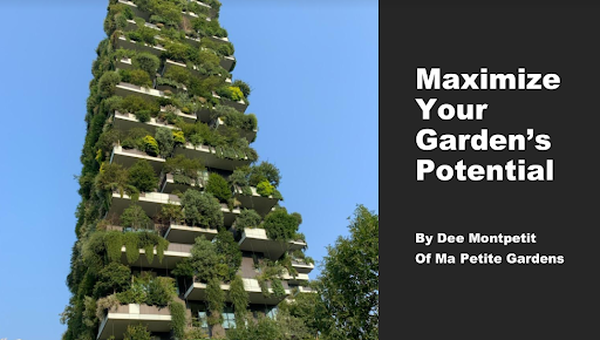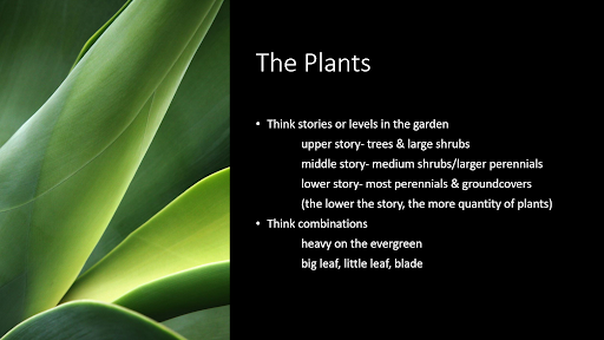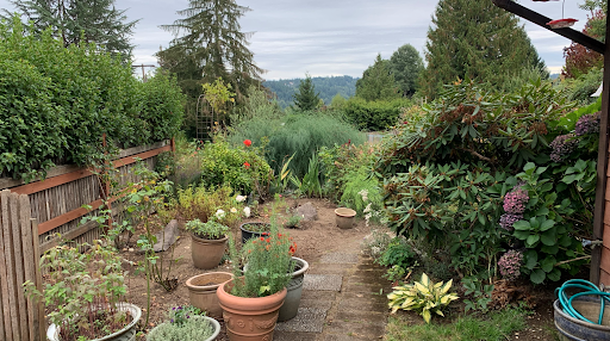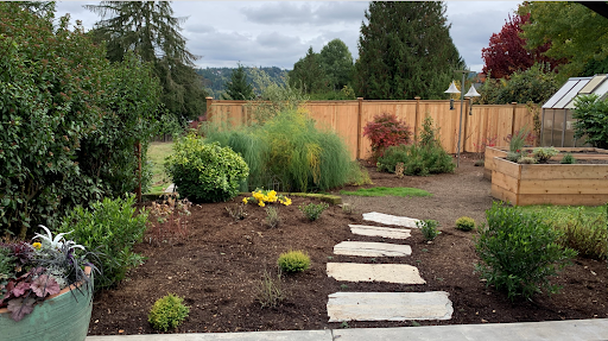
<-- Back
Visually Pleasing Landscapes
Proportion
To create a visually pleasing space, you need proportion. So what does that mean? I guess the best way to describe that would be if you have a 3000 square foot house and you bought a plant at Fred Meyer that was this tall and you put it by your front door. That is so totally out of proportion to the surrounding area. When you bring anything new in, whether it's pottery, a focal point or tree, you want to make sure that it's in proportion to the surrounding area in the house.
Balance
Balance is just simply what you do on one side you want to do on the other. If you like a more formal look, you could duplicate or, if you like a less formal look, it would be asymmetrical. Something different that you need to have that balance. You can even borrow from your neighbor's yard. If your neighbor has a really small yard and it just doesn't work for you to have another garden on one side of the house, then that can provide a balance that's needed.
Focal Point
The focal point, a really strong focal point is very important. You don't need a focal point in every garden bed. But some of the main gardens that need a focus to draw your eye out into the landscape, and then to tie everything together.
Simplicity
Simplicity is important. Sometimes you just need more of the same thing. If you have a garden bed that has five or six different plants in it where you have a big hole. Sometimes you just need an extra one of what you already have. You don't need to add something new to it.
Lines
Line refers to the flow of the garden and it also draws your eye into the garden. One of the best things you can do in a garden, and it's really remarkable the difference between sort of a maybe an erratic border, but having a crisp garden border. It just makes a huge difference, just those crisp, clean lines can help a lot.
Unity
And then unity is unifying the garden. And how we do that usually is through repeat plantings. So not having 100 different types of plants just sort of willy nilly, but repeating the plantings throughout the garden.
Visually Pleasing Landscapes
Proportion
To create a visually pleasing space, you need proportion. So what does that mean? I guess the best way to describe that would be if you have a 3000 square foot house and you bought a plant at Fred Meyer that was this tall and you put it by your front door. That is so totally out of proportion to the surrounding area. When you bring anything new in, whether it's pottery, a focal point or tree, you want to make sure that it's in proportion to the surrounding area in the house.
Balance
Balance is just simply what you do on one side you want to do on the other. If you like a more formal look, you could duplicate or, if you like a less formal look, it would be asymmetrical. Something different that you need to have that balance. You can even borrow from your neighbor's yard. If your neighbor has a really small yard and it just doesn't work for you to have another garden on one side of the house, then that can provide a balance that's needed.
Focal Point
The focal point, a really strong focal point is very important. You don't need a focal point in every garden bed. But some of the main gardens that need a focus to draw your eye out into the landscape, and then to tie everything together.
Simplicity
Simplicity is important. Sometimes you just need more of the same thing. If you have a garden bed that has five or six different plants in it where you have a big hole. Sometimes you just need an extra one of what you already have. You don't need to add something new to it.
Lines
Line refers to the flow of the garden and it also draws your eye into the garden. One of the best things you can do in a garden, and it's really remarkable the difference between sort of a maybe an erratic border, but having a crisp garden border. It just makes a huge difference, just those crisp, clean lines can help a lot.
Unity
And then unity is unifying the garden. And how we do that usually is through repeat plantings. So not having 100 different types of plants just sort of willy nilly, but repeating the plantings throughout the garden.
Mature Landscape TIPS
When I go out for my gardening consultations, a lot of times it's mature landscapes. People have lived in their home for maybe sometimes decades or they've moved into an older home that has an established landscape. And one of the best things you can do is to edit. If you have a mature landscape that's not really working for you or that you don't enjoy, this will be life changing for you.
And are you familiar with Marie Kondo and her book, Spark Joy? She refers to things that you own, items that you own, clothes that you own. Asking each individual item- does this spark joy? I encourage you to do that out in the garden with the different plants that you have.
You may have an overgrown shrub in front of your house, but you have to prune four feet twice a year. Give yourself permission to remove that because it's never going to get any better. And think of what you could be doing with that time that you were spending on cutting, pruning the shrub, or whatever you're doing, watering an extra amount or whatever plant that's really draining on you, but not sparking joy. Give yourself permission to get rid of this.
Then I like to think about gardens as a stage. When you go and you see a play and you usually have a few superstars, right? And then there's lots of supporting actors.These supporting actors are going to be your everything shrubs. Those plants that might be a little less showy. Those are really important to create a visually pleasing landscape.
And then also the smaller the garden bed and generally the fewer types of plants you have. For example, I had an installation this past weekend. It was in Trilogy and they had a bed that was about a foot directly against the house. There was the house, this one foot bed, and then a sidewalk. They had five or six different types of plants that were overwhelming. This is where simplicity and having some supporting actors that are going to be the right plant in the right place and not be overwhelming is important.
We talked about sometimes I see more of the same thing repeating your plantings and then pots shrink when you drive them home. Invest in good quality plants that are the appropriate scale to the surrounding area. A couple of consultations, and there's no judgment here - I just find it interesting, but a couple of consultations have gone to the homes are very big and very nice neighborhoods. They bring me in and then they show me the $100,000 kitchen remodel, and I know I saw that pot outside of Costco. So it's just interesting. Everybody sees your front entry unless it's shielded by foliage or too far from the road. But, fewer people see your kitchen.
When I go out for my gardening consultations, a lot of times it's mature landscapes. People have lived in their home for maybe sometimes decades or they've moved into an older home that has an established landscape. And one of the best things you can do is to edit. If you have a mature landscape that's not really working for you or that you don't enjoy, this will be life changing for you.
And are you familiar with Marie Kondo and her book, Spark Joy? She refers to things that you own, items that you own, clothes that you own. Asking each individual item- does this spark joy? I encourage you to do that out in the garden with the different plants that you have.
You may have an overgrown shrub in front of your house, but you have to prune four feet twice a year. Give yourself permission to remove that because it's never going to get any better. And think of what you could be doing with that time that you were spending on cutting, pruning the shrub, or whatever you're doing, watering an extra amount or whatever plant that's really draining on you, but not sparking joy. Give yourself permission to get rid of this.
Then I like to think about gardens as a stage. When you go and you see a play and you usually have a few superstars, right? And then there's lots of supporting actors.These supporting actors are going to be your everything shrubs. Those plants that might be a little less showy. Those are really important to create a visually pleasing landscape.
And then also the smaller the garden bed and generally the fewer types of plants you have. For example, I had an installation this past weekend. It was in Trilogy and they had a bed that was about a foot directly against the house. There was the house, this one foot bed, and then a sidewalk. They had five or six different types of plants that were overwhelming. This is where simplicity and having some supporting actors that are going to be the right plant in the right place and not be overwhelming is important.
We talked about sometimes I see more of the same thing repeating your plantings and then pots shrink when you drive them home. Invest in good quality plants that are the appropriate scale to the surrounding area. A couple of consultations, and there's no judgment here - I just find it interesting, but a couple of consultations have gone to the homes are very big and very nice neighborhoods. They bring me in and then they show me the $100,000 kitchen remodel, and I know I saw that pot outside of Costco. So it's just interesting. Everybody sees your front entry unless it's shielded by foliage or too far from the road. But, fewer people see your kitchen.
Garden Consultation
When I go on a gardening consultation, I ask very specific questions, and that helps me determine what types of plants to choose for the garden. And these are questions that you can ask yourself.
When I go on a gardening consultation, I ask very specific questions, and that helps me determine what types of plants to choose for the garden. And these are questions that you can ask yourself.
- What is the most important and how is it going to function?
- Is it just something that you're going to see from your bedroom window?
- Do you really want it to be a showpiece?
- Do you want to put a fire there?
- Are you never going to see it because it's on the backside of a shed that you never go behind?
- And then, how many hours a week are you willing to spend in the garden? I would imagine some of you still work and time is very limited. It helps when I ask my clients to be realistic. 2 hours, 5 hours, all day? These are important questions because you wouldn't want any plants that would be more high maintenance and would require a lot of extra attention.
- And then favorite colors, you paint your walls and your homes the colors that you like, and just let that be an extension in your interior.
- And then do you have irrigation? This is a very important question. Is there water access? If you don't have water access, you don't have time to water and you're not willing to either install irrigation or put in drip irrigation. Then give me a garden that has something other than a plant,

The Plants
Levels
Now we're talking about the plants. I think it helps to think about different levels or different stories. Your upper story is going to be your trees are really large, shrubs 20 feet tall, 15, 20 plus. Your middle story, you're going to see those shrubs that are going to be in that 6 to 3 feet.That's the middle story. And then the lower stories. It's most perennials and ground covers. In general, the smaller the plant, the more quantity of the plants you want. Think of one tree. You will have 15 shrubs (they don't have to all be the same things), you want to do at least three depending on the size of the bed. And the perennials, you're going to get 5 Echinacea, not one Echinacea, an xxx, one xxx and one xx. If you're going to put it in, you need to invest in at least three for it to have real visual impact unless you want to look at specific things. Then combinations.
Combinations
If it's an area that you see from inside the house and there are 12 months in the year, you want something that's going to look good year round. Go heavy on the Evergreen. Now if that's not so important If it's not an area that you see. I actually have been in my home and gardening in my garden now for 25 years, 25 years this year. And there is an area behind the shed that I was just really struggling with. There's something about being in a place I think for so long, and you just need fresh eyes as you've seen this for so long. It was really a blank space and then it just hit me one day that I love flowers. I'm going to do flowers and plants that are deciduous and herbaceous perennials. Now it looks beautiful. And I don't have to look at it in the winter time, so it works great.
And then I thought of just how different types of foliage work together. And here we have a Variegated Spider’s Web Fatsia. If you have a shady spot and you need a real showpiece, this will make a great focal point. This is a real workhorse. And how many of you have Fatsia? You love them. Yeah. I mean after they're established you can water or not. They will just grow and be fabulous. And the great thing about this one is it gets probably six feet by six feet. The solid green one will get 15 to 20 feet tall. It's enormous, but you can cut it down to the ground and every year it comes back and it'll grow like 6 feet. Fabulous plant.
So the whole texture, right? Same thing here. This is Hosta Blue Elegans. And I love the blue Hosta. This is because the slugs don't like them as much. Then the leaves are a lot more fibrous and they're just not as appetizing. So I have this in my garden in three different places. When they're young, the slugs are interested, but once they get some birth to them, they leave them alone. So it's called Hosta Elegans.So if you need a big texture or a large texture in your garden, this is a great choice. And then when you add the ferns in this combination, isn't that just beautiful?
And then the variegated boxwood also. Boxwood has kind of a bad rap. And I'm telling you, variegated boxwood is awesome. Drought tolerant, full sun, full shade - doesn't matter. They average seven by five if you prune them, but easy just to sort of give it a little haircut once a year. And then you have this beautiful combination for a shady garden. So think of different textures. And I'm saying all this for the next slide.

Customer Project - Transformation through Editing
Oh, so I just want to talk briefly about a project I did last year and speaking of being in a home for decades, this lady reached out to me and she had been in her house in Redmond for 40 years and her husband had done all of the gardening. She did all of the inside work and it worked right for them. But he had recently passed away and she came to me and she said, I love to garden, I love edible gardening, I love my birds, I love flowers. But I am so overwhelmed, I don't even know where to start. And she had some health issues, too, that made it difficult for her to kind of maneuver around in the garden. Everything was so overcrowded.
These pavers here, they were all uneven. And this is a good time to mention that if you're going to invest in pavers, stepping stones, you want to get big pieces. And the reason being is, well, first and foremost, just from a functional standpoint, they're not going to shift. And believe me, a mole can muck it up on one side because I've seen that before. So large pieces and I'm talking like 2 feet by 1 foot as a minimum. And so the other issue, there were lots of roses. So she really needed me to create a low maintenance garden for her. And when I think of roses, I do not think of low maintenance.
And then my first question to her was, Well, do you like roses? And she said, No, not really. But my husband used to buy them for me. So she had like 15 roses. She felt kind of guilty about getting rid of things. I told her to pick out two or three that were her favorites, and then the rest of them she could give to family, friends, and neighbors. And she loved that idea. And that's what you want to do.
All this extra fence actually went nowhere and at the end it was completely open, so there was no purpose for it. So the fence was removed. And then these pots, Lord, have mercy. I felt I would start hyperventilating, thinking, Oh my God, she's going to come out here and water a lot every day. And so the question is, do you love these pots? No, I don't, but she still liked the plants. And so what we did is we planted the plants that she liked in the landscape. The herbs we put in some of the new raised beds that we did custom for her that were about three feet tall. And let me tell you, the older I get, the better it sounds to me not to have to bend over in the garden.
So this is perfect for her. And then one other thing for rhododendrons. Have you ever heard of the Azalea Lace Bug? So there's a pest that came down from B.C. It and it's really just decimating our rhododendrons and our azaleas. Every consultation I go to is an issue. That was an issue with this Rhodie. And not to mention the fact that it was way too big and approaching the walkway. Just have a look at your Rhodies. They're just becoming more stressed because their summers are getting so hot and dry. They actually need summer moisture. And I think as Washingtonians, we take them for granted. We think they are like Arborvitaes and we don't have to water them. And so then, you know, now we've got these warmer temperatures and it's drier and under stress. Whenever a plant is stressed, it's an opportunity for xxx. So take care of your Rhodies and Azaleas.

This was the end result. So we removed the fence and her kitchen window was over here. She wanted a pot, but none of those were really special and weren’t on the right scale with this brand new patio installed. And I said, let's just get one great big pot and then that's the only one you have to take care of. And these are the custom beds that we made. This was very early in the season, so it looks very messy and this is all grass seed, but this gives you an idea of how you can transform your garden through editing.
<-- Back
This was the end result. So we removed the fence and her kitchen window was over here. She wanted a pot, but none of those were really special and weren’t on the right scale with this brand new patio installed. And I said, let's just get one great big pot and then that's the only one you have to take care of. And these are the custom beds that we made. This was very early in the season, so it looks very messy and this is all grass seed, but this gives you an idea of how you can transform your garden through editing.
<-- Back
